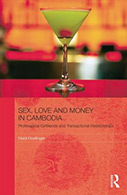Sex, Love and Money in Cambodia: Professional Girlfriends and Transactional Relationships

Author: Heidi Hoefinger
Publisher: New York: Routledge, 2013. 218p.
Reviewer: Susan Dewey | January 2015
Anthropologist Heidi Hoefinger’s work with young women in Phnom Penh, Cambodia involved four periods of research from 2003-2010, during which she engaged in specific purposive sampling as a means to conduct interviews with 281 individuals — including 115 women, 125 men, and 42 workers at non-governmental organizations, government agencies, and academic institutions (35). Comprised of seven chapters, her book resembles much of the contemporary sex work research literature in arguing for the need to de-stigmatize the means by which transactional sex may facilitate individual self-actualization, albeit sometimes in extremely constrained socioeconomic circumstances. The author advocates a discursive reframing of sex work in order to better understand the cultural and socioeconomic contexts in which the Khmer women she terms “professional girlfriends” live, work, and aspire to a better life.
Chapter One, “Professional Girlfriends and Transactional Sex,” introduces the concept of the professional girlfriend, defined as women ranging in age from 16 to 35 and employed at hostess bars or other entertainment venues frequented by expatriate men. Hoefinger notes that these women, who do not self-identify as sex workers, share three distinguishing characteristics: they cultivate relationships with expatriate men as their primary means of economic support; engage in a number of simultaneous relationships unbeknownst to the men involved; and establish emotional intimacy with the men (3-4). The author argues that the label “professional girlfriend,” rather than the more widely used “sex worker,” more accurately captures the complex ways in which money plays a role in the women’s intimate relationships. Hence, while many of the women with whom Hoefinger lived and worked expressed a desire for a monogamous relationship with a man, their transactional sexual relationships with multiple expatriate men provided a means by which they could improve their socioeconomic status while engaging in high status conspicuous consumption practices. The author is careful to note that this phenomenon dates to at least the seventeenth century, when women throughout Southeast Asia engaged in temporary marriages to Portuguese, Spanish, English, Dutch, Chinese, and Japanese merchants and officials. Like their predecessors, contemporary professional girlfriends may experience freedom through such relationships, which position them outside of rigid social systems — albeit only for the duration of the relationship.
Chapter 2, “Methods, Ethics, and Intimate Ethnography,” explores issues related to research design and ethical quandaries that arise from participant observation as an ethnographic method, particularly with respect to positionality. Hoefinger expounds at length on the thought processes that informed her project, thereby providing an elaboration on the essential question that feminist ethnographers have now been exploring for decades: “will differences in power, class, culture, ethnicity and desire always affect these transnational relationships in a negative way or can true friendships and relationships develop without these dominant hegemonic constraints haunting, tainting and somehow devaluing them?” (31). With this somewhat existential question in mind, the author details the mixed methods framework she employed as a means to equalize these inequalities: a quantitative survey on relationships and intimacy, a participatory project entitled “Global Girls: Autobiography & E-literacy Project,” and a Western European documentary project about the women’s lives, on which the author served as a consultant.
Chapter 3, “Sex, Work and Agency,” provides a discussion of how Hoefinger came to conceptualize her understanding of the women’s lives in the early stages of her fieldwork. She draws heavily upon other sex work researchers, particularly Denise Brennan, to describe the means by which women come to conceive of their transactional sexual relationships as the best choice out of an otherwise severely constrained menu of life options. Most interestingly, this chapter also explores the concept of “celebrity status” recognized by their communities, families, and peers as a consequence of their lucrative command of the English language and Western European and North American cultural norms. Women typically acquire these skills by living and working with other professional girlfriends in arrangements where “six to seven girls shared not only a room, but also all makeup, hygienic supplies, clothing and food” (79).
Chapter 4, “Politics, History and The Sexual Landscape,” explores the historical and politico-economic context in which transactional sex takes place in Phnom Penh. Hoefinger describes this context as one informed by “French colonialism, civil war, the Khmer Rouge genocide and its legacy, stark human rights abuses, rampant corruption, a precarious infrastructure, and political instability” (83). This follows a sadly familiar script in which “the troops were replaced with tourists” (86) as well as a politico-economic structure in which, as Hoefinger puts it, “most things are commodified and nearly any situation can be resolved through money” (87). Chapter 4 also discusses violence against women, particularly father-daughter incest, child sexual exploitation, gang rape, and the practice of an older person (usually a woman) selling a minor girl’s virginity. Hoefinger also details her “Global Girls” action research project, in which she facilitated women’s acquisition of computer skills in ways that aided their own stated goals of furthering their trajectories as professional girlfriends.
Chapter 5, “Sexuality, Subculture and Alternative Kinship,” describes the socialization processes women experience, often through living and working with older women who impart knowledge to them. Hoefinger uses the notion of the hostess bar (or related entertainment venue) as a “third space” in which women form fictive kinship bonds that help them to negotiate an environment in which “much alcohol consumption, drug use, depression, ‘heartache,’ violence and self-harming occurs” (107). Hoefinger is careful throughout this chapter to include accounts of violence from both women and their male clients, the latter of whom reported regular occurrences of being punched, kicked, spat on, bitten and slapped by their (usually intoxicated) Khmer girlfriends” (140). What the author terms “bar girl subculture” functions as a strategic tool through which women develop support networks, some of which resemble patron-client relationships, and where “the metanarrative of sex is put to work for their own benefit” (112). Hoefinger describes the professional girlfriends’ highly stratified world, in which youth, English proficiency and associated Western European and North American cultural knowledge generally (but not always) result in more lucrative arrangements with expatriate men.
Chapter 6, “Constructions of Love and The Materiality of Everyday Sex,” further elaborates on the inherently transactional nature of all intimacy. Findings presented in this chapter draw upon Khmer media depictions of love and romance, including adult paranoia about young people engaging in sex, and the melodramatic love and romance of popular Southeast Asian and Chinese soap operas. Hoefinger devotes great care in this chapter to describing the ways that women and men in the study defined love, primarily by analyzing the results of a quantitative survey she conducted. She notes that for many women “love was conflated with care, respect, appreciation and devotion, and desirability was based not necessarily on physical appearance or age, but a man’s ability to provide, to care for, to be kind and faithful and to treat women well” (150). In an environment in which both women and men seem carefully attuned to the meanings ascribed to the economic and sexual exchanges that take place between them, Hoefinger notes the emergence of relationship practices in which no economic sharing takes place as a means to assuage both parties’ concerns about the possibility for economic exploitation.
Chapter 7, “Moving Beyond Sex Work,” is the book’s quite brief concluding chapter, in which Hoefinger argues that her notion of the professional girlfriend may prove useful for other researchers by “applying the model of transactional sex and materiality of everyday relationships” (27). Hoefinger closes with the argument that a professional girlfriend’s path to financial independence for both herself and her extended family through cultivating a relationship with an expatriate man, is littered with obstacles that include structural racism and sexism, sex work-related stigma, and gendered sexual violence. Yet it is precisely within the confines imposed by such obstacles that professional girlfriends negotiate strategies to improve their lives, albeit on terms that are not of their own making.
The book has four primary strengths that render it a useful contribution to the crowded field of ethnography on sex work. First, Hoefinger provides a level of detail on her research design and methodologies that is rather uncommon in ethnographic works; this should prove useful to novice researchers. She also engages in a thoughtful discussion on the contentious issue of reciprocity in feminist research, including the ways in which research participants “‘exploit back,’ in ways that are relevant to them” (55). While Hoefinger’s use of “professional girlfriend” will not be useful to all sex work researchers (particularly those who work in more explicitly transactional contexts), it will encourage further critical thinking about emic language. Likewise, it may encourage further engagement with the politics and costs of framing particular behaviors in particular ways, as sex workers themselves rarely have the opportunity to directly control these discursive flows. Finally, Hoefinger makes an important contribution by including men (and particularly violence against male clients) in her study.
As with any scholarly text of this length, Hoefinger’s book also has some weaknesses. First, Hoefinger demonstrates a frustrating lack of engagement with relevant literature — particularly the substantial body of work published in the last decade on hostess bars by Tiantian Zheng, Rhacel Parreñas, Anne Allison, and many others; none of whom are cited. The book could have benefited from more editorial engagement, as nearly half the manuscript consists of discussion about methods, positionality, and research design — all of which could have been condensed into a single introductory chapter that included historical context. For instance, in Chapter Three this reader longed for more when Hoefinger noted, “[a]nd in a transient city such as Phnom Penh, where dramatic hellos and goodbyes are a part of everyday life and where knowing someone for a month is considered a ‘long time,’ familiarity and a shared history are cherished and nurtured” (52). In the absence of information on historical or contemporary context, such intriguing statements fall flat. The findings presented may suffer from selection bias, as in Chapter 2 for instance, where Hoefinger notes that she “chose only to include English-speaking bartenders and waitresses because a key element of the research was the assessment of how degrees of English fluency affect work and status” (40). Ignoring women who only speak Khmer, or just a bit of English, neglects what could have been valuable insights into how this lack of linguistic privilege impacts their lives. Hoefinger, in contrast to most ethnographers, does not often include quotes from the women she worked with. If she had done so, she may have found as others have, that the women may have expressed themselves more freely and eloquently in Khmer than in stilted English. This is a possibility that Hoefinger does not address.
Taken as a whole, this book constitutes a useful contribution to the burgeoning literature on sex work. Hoefinger’s balanced presentation of multiple- and sometimes competing- perspectives will help other sex work researchers to engage in the kinds of discursive shifts that she, and many others, have proposed as necessary in order to advance understandings of this complex topic.
Susan Dewey – Associate Professor of Gender/Women’s Studies, University of Wyoming


